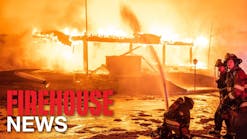Ohio Fire Supervisors Race to Scenes at Over 100 MPH
Source The Columbus Dispatch, Ohio
June 17--Seven Columbus fire supervisors raced to emergencies at more than 100 mph this year, an internal investigation has determined.
That didn't violate the Fire Division's policy, and they likely won't be disciplined. But the incidents have sparked a debate among city officials about how fast is too fast when responding to emergencies.
Fire administrators launched the investigation despite strong objections from fire union officials. The city's new GPS tracking system had flagged SUVs driven by firefighters serving in the role of battalion chief who drove between 101 and 113 mph a total of 13 times in a two-month span, according to documents obtained by The Dispatch through a public-records request.
Battalion Chief Jack Reall, who also is the president of the International Association of Fire Fighters Local 67, was one of those whom investigators questioned after he was clocked driving his Ford Interceptor SUV at 108 mph in February.
Reall has said that any discipline arising from the GPS units has to be approved by the union through contract bargaining. He did not return a call last week seeking comment.
The city has agreed to midterm bargaining with the union, while Safety Director Mitchell J. Brown has instructed his staff to develop standards for speed and other data reported by the GPS units, such as idling times and routes traveled.
The Fire Division's current policy allows firefighters to exceed the speed limit as long as road and weather conditions are favorable. Fire Chief Gregory A. Paxton has informally suggested during administration meetings that no fire vehicle should travel more than 90 mph, according to statements one battalion chief made during the investigation.
"The 90 mph statement was information that may be considered when a more-formal policy is developed," Battalion Chief Patrick Ferguson said in an email response. "It is our understanding that formal discussions about the policy is being handled by city leaders and IAFF Local 67."
Everyone involved agrees that vehicles should travel reasonable speeds based on the time of day, the amount of traffic and weather conditions.
Many firefighters, including Reall and Ferguson, have argued that every second matters when lives are at stake.
"The issue boils down to how fast does the public want us to respond?" Ferguson said. "If you're having a heart attack or some emergency, do you want us to get there by going the speed limit or going as fast as we reasonably can?"
Fire administrators argue that speeding makes a negligible difference, especially for those serving as battalion chiefs, who carry little or no lifesaving equipment and usually are not the first to arrive at an emergency. They also argue that most fire apparatus, such as engines and ladder trucks, can't reach speeds of more than 90 mph anyway.
"The battalion chiefs play a very critical role in managing logistics and running the scene at an emergency," said Mike Halloran, an assistant city attorney and a firefighter. "I think like everything else firefighters do, they have to balance risk with benefit, and those responding to a scene do so safely by using their training and relying on their protocols."
Halloran said safety has to be "the top priority."
The Ford Interceptor SUVs the battalion chiefs drive have 304-horsepower, V-6 engines rated for speeds up to 131 mph.
State law allows emergency vehicles to reach any speed necessary as long as there is "due regard for the safety of all persons and property upon the highway." Fire departments across the state treat speeding differently.
In Akron, fire vehicles may go no more than 5 mph over the speed limit. In Youngstown, it's 10 mph.
Youngstown Fire Chief John J. O'Neill Jr. said traveling faster than 10 mph over the speed limit makes little difference in response times.
Dayton mirrors Columbus, allowing firefighters to speed at any rate as long as conditions are favorable.
Columbus Mayor Michael B. Coleman said through his spokesman that he is awaiting a recommendation from Safety Director Brown before he comments. It was Coleman who pushed for the GPS units to reduce fuel costs, pollution and misuse of vehicles. The mayor said he grew tired of seeing news-media reports of workers' driving their vehicles to unauthorized locations and sometimes leaving them idling while they ate lunch.
@DispatchSully
Copyright 2013 - The Columbus Dispatch, Ohio





